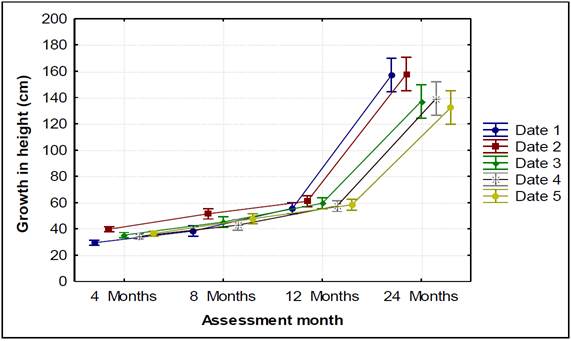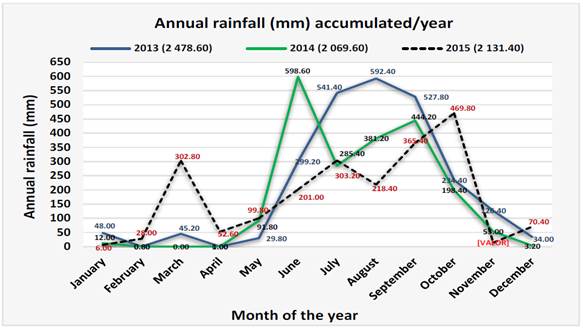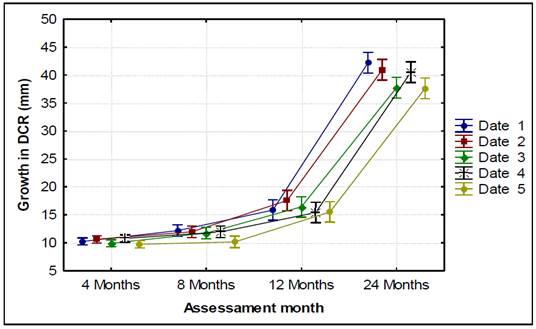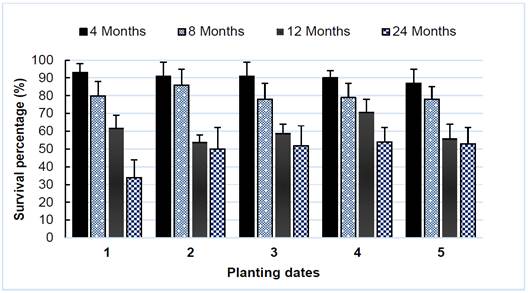Introduction
The land use in the state of Michoacán is considered with a forest vocation, since this state ranks the third national place in timber production, the first place in resin production and the fifth place in biodiversity (COFOM, 2015). In the state, the establishment of forest plantations has been promoted, mainly using species of the genera Pinus, Eucalyptus and Cupressus. With purposes of conservation and restauration of areas in degraded soils without use by agricultural crops, zones of degraded forest, or for planning and executing management plans of river basins, among others (SEMARNAT, 2011 a,b; SEMARNAT, 2013).
In Mexico, the annual mortality rate of forest plantations was 60 % in 2007 (SEMARNAT, 2011a), 55.6 % in 2009 (UANL, 2009; UACH, 2010), and 43 % in 2016 (CONAFLOR, 2016). An assessment of reforestations established in the state of Michoacán revealed that the seedling survival rate at the following year after plantation was 37.8 %, due to the inadequate selection of species and provenances, low-quality seedlings, the scarce preparation of the plantation sites, no weed control, late planting dates, and others (Sáenz & Lindig, 2004).
The Indigenous Community of Nuevo San Juan Parangaricutiro, Michoacán has a total surface of 18,138 ha-1, of which 10,870 ha-1 are covered by forests, whereas the rest of the surface (7,268 ha-1) has diverse uses, where there is a high potential for the establishment of forest plantations. Some of them date back to the 1970s, with introduced species, mainly of the Pinus genus, and Cupressus on a small-scale (Aguilar, 2008). The planting date is considered as a fundamental factor in forest plantations. However, the studies about its influence on the response of plant establishment in the plantation site are scant (Serrada et al., 2005; Cortina et al., 2006 and 2013), although this variable determine the subsequent evolution of environmental conditions that directly influence survival rate in a higher percentage (Navarro et al., 2006a; Palacios, 2016).
Some authors point out that the survival rate of pine and oak species is affected by the combined effect of the planting date, the site preparation and the plant quality (Navarro & Palacios, (2004); Rodríguez & Cerrillo, 2005; Palacios, 2016). Other researches emphasize that the planting date for Pinus species in Mediterranean climates does not significantly affect the survival rate, but significantly influences the growth in height, the diameter at the base, the slenderness index and the hydric potential. Also, it was suggested that in all measurement dates, the growth in height and diameter were higher for early planting dates than for late planting dates (Royo et al., 2000; Ariza et al., 2008). Similarly, in Mexican pine species under experimental conditions, the growth in height was larger at the first planting dates than at the second planting date, due to climatic conditions favoring their subsequent development in field (Rodríguez, 2013). The objective of this study was to assess the survival rate and development of Pinus pseudostrobus Lindl. seedlings, established at five planting dates, in land lots belonging to the Comunidad Indígena de Nuevo San Juan Parangaricutiro, Michoacán (CINSJP).
Materials and Methods
Study area
The plantation was located in a site called “El Tejamanil”, in the Comunidad Indígena de Nuevo San Juan Parangaricutiro, Michoacán (CINSJP), Michoacán, in the coordinates 19° 24´16.7” north latitude and 102° 14´12.7” west longitude, at an average altitude of 2,735 masl. It is part of the Trans-Mexican Volcanic Belt, the Balsas River (HR18) Hydrologic Region, and the Cupatitzio River (G) Sub-basin (INAFED, 2018). Climate is humid temperate with summer rains C (m) (w) (Koppen modified by Garcia, 1973), and a percentage of winter rains lesser than 5 %. Predominant soil is humic Andosol (78.31 %), Luvisol secondary soil (12.79 %) and Regosol (8.9 %) (INEGI, 2009; UNDP, 2012). Surrounding vegetation to the plantation site is shaped basically by native mixed pineoak forest, mainly with P. pseudostrobus and Pinus montezumae Lamb. trees. The mean slope of the site was 5 %. The site was used previously for agriculture and cattle grazing.
Plant characteristics. Plants were produced in “El Durazno” forest nursery of the CINSJP. Pinus pseudostrobus plants was produced in 5 x 20 cm black polyethylene bags (1+1) with 393 mL volume, used substrate had 60 % of oak soil (decaying litterfall) and 40% of ginger soil (topure-andosol soil). Initial average in height and diameter at the base of the plant when establishing the plantation was 35.81 ± 3.2 cm and 9.0 ± 1.2 mm respectively.
Plantation establishment. The planting was conducted at the beginning of the rainy season (July-August) in the region of the CINSJP. The planted seedlings had 24 months in the forest nursery. The first planting date was on July 1st of 2013 and every 15 days an experimental lot was planted. The planting was realized with the 40 x 40 x 40 cm planting hole system, under real frame distribution, and 2.0 x 2.0 m spacing between rows. The plantation site had a previous agricultural use, therefore, soil preparation was not done. The assessed treatments are presented in Table 1.
Table 1 Treatments assessed at five planting dates of Pinus pseudostrobus Lindl. in the CINSJP, Michoacan
| Treatment | Planting dates |
|---|---|
| 1 | July 1st, 2013 |
| 2 | July 15th, 2013 |
| 3 | July 30th, 2013 |
| 4 | August 15th, 2013 |
| 5 | August 30th, 2013 |
Experimental design and assessed variables. A randomized complete-block design was used, with five treatments (five planting dates) and 4 repetitions (blocks). Each experimental unit had 25 plants, a total of 100 plants per treatment. The first planting date was established on July 1st (F1), subsequently on July 15th (F2), July 30th (F3), August 15th (F4) and finally August 30th of 2013 (F5).
Assessed variables were: total plant height (cm), measured with a topographic rod (Apex model), set in cm; the diameter at the base of the plant (mm), measured with a Neiko digital Vernier calibrator; and the survival rate (alive or dead) through a direct count. In total, five measurements were realized per planting date, since its establishment on July 1st (F1), July 15th (F2), July 30th (F3), August 15th (F4) and August 30th (F5) of 2013, and subsequently at 4, 8, 12 and 24 months once each treatment was established on the corresponding planting date.
Data analysis
With the variables total height and diameter at the base of the plant, an analysis of variance (ANOVAtest) was performed with the STATISTICA software, version 13. Survival data were log-transformed to be analyzed. Planting date was chosen as the grouping variable (F1, F2, F3, F4 and FR5). In those variables where significant differences were found, a Tukey’s Multiple Comparisons test was performed (p>005) with a confidence level of 95 %. The used mathematical model was the following:
Yij = M + Ai + Bj + Ai*Bj + (Eij)
Where:
Yij = random variable representing the value of the response in the jth observation of the ith treatment.
M = constant representing the average response of the Y variable.
Ai and Bj = effects of i treatment (i = Date: 1, 2, 3, 4 and 5) and j time (j = 1, 2 and 3 years).
Ai*Bj = effect of i treatment - j time interaction.
Eij = experimental error (Norman et al., 1996).
Results and Discussion
Growth in height. In all assessment periods, the established date on July 15th (F2) showed the highest growth in height, whereas it only presented similar growth to the other dates at the assessed year. After 24 months, the growth was higher in established dates from July 1st to 15th corresponding to planting date 1 and 2, respectively (Figure 1), since the average initial height of the plantation was of 35.81 cm, where there was a 122 cm growth at the end of the measurement period. Differences were maintained 157 ± 2.5, 157.8 ± 4.1, of plants established from July 1st to 15th compared to 132.3 ± 1.3, 139 ± 2.1 of plants from August 15th to 30th. Moraga et al. (2000) obtained similar results, who in their study on the effect of planting date on growth in height in Pinus halepensis Mill., found that at the end of the first summer, differences between the plantation of higher growth (January) and lower growth (February) were 8 cm. These differences increased during the second year, and exceeded 20 cm.

Figure 1 Growth in height of Pinus pseudostrobus Lindl at five planting dates assessed at 4, 8, 12 and 24 months following its establishment in the CINSJP, Michoacan.
Throughout the assessment period, the date corresponding to July 15th (F2) presented a higher growth in height in comparison to the rest of planting dates. Since the assessment at four months, the repeated-measures ANOVA revealed highly significant differences (p<0.0001). Therefore, for each assessed period, significant differences were observed in 8 and 24 months (Table 2), where, F2 stands out from the beginning (average initial height of 35.8 cm) with differences from 10 to 90 cm between each assessment period, In this case, the planting date had a significant effect on total height.
Table 2 Mean comparison of growth in height of five planting dates with Pinus pseudostrobus Lindl., established in the CINSJP, Michoacan
| A: Independent ANOVA and estimated contrasts | B: Repeated measures ANOVA | ||||||
|---|---|---|---|---|---|---|---|
| Assessed dates | ***4 months |
**8 months |
12 monthsNs |
*24 months |
Inters | Intras | |
| X | X-Treat | ||||||
| July 1st, 2013 (D1) | 29.4c | 38.4c | 55.7a | 157.0a | *** | **** | **** |
| July 15th, 2013 (D2) | 39.8a | 51.5a | 61.1a | 157.8a | *** | *** | *** |
| July 30th, 2013 (D3) | 35.3ab | 45.2ab | 59.5a | 137.1b | *** | ** | ** |
| August 15th, 2013 (D4) | 34.36b | 42.9b | 57.4a | 139.2bc | *** | *** | *** |
| August 30th, 2013 (D5) | 36.4a | 45.7ab | 58.4a | 132.3c | *** | * | * |
A: Independent comparisons of growth in height by planting date, using ANOVA. Values of p≤0.0001, 0.001 and 0.01 are highly significant (****) and Ns > 0.05. B: repeated measures ANOVA. The «inter-treatment» effects estimated the differences between the different planting dates over the assessed time. The “intra-treatment” effects estimated the overall effects over the assessed time and the effects of assessed time X planting date interaction where F-value was 0.05.
Data from the climatological station of “El Rosario,” close to the “El Tejamanil” planting site, showed that during the establishment of the two first planting dates in July of 2013, the precipitation was 541.40 mm, and the cumulative rainfall from July to December of the same year was 2,056.40 mm (Figure 2). These data showed that planting dates 1 and 2 presented an excellent growth in height, since they have a higher humidity availability for the subsequent development of the plant. Records of the same station indicated that in the two subsequent years (2014 and 2015) during the months in which the plantation was established, there was a slight decrease in precipitation (Figure 2). In planting dates 4 and 5, established on August 15th and 30th of 2013 respectively, the accumulated precipitation from August to December was 1,515 mm with a difference of 541.40 mm in comparison to the accumulated precipitation from July to December of the same year. Therefore, in late planting dates, plants presented a lower growth in height compared to early planting dates, due to the accumulated rainfall during its establishment. The effective use of water by plants is related to the root development after the establishment process. Therefore, the rainfall at a favorable planting date determines, to a higher extent, the seedlings growth and survival rate, subsequent to their establishment (Villar-Salvador et al., 2015).

Figure 2 “Annual cumulative rainfall/year (mm), during the two-year experiment period of five planting dates (Climatological station “El Rosario”, municipality of Nuevo San Juan Parangaricutiro, Michoacan).
Monthly cumulative rainfall during July-August presented differences up to 300 mm from one year to another. During the plantation establishment in July 2013, the rainfall was higher, although it was reduced to 200 mm for the same planting period in the following year (2014). The same situation happened in 2015, for the plantation established in August (F4 and F5), the monthly cumulated precipitation decreased to 373 mm regarding the one presented during the same month in 2013.
In this regard, Larcher (2003), and Fitter & Hay (2012), pointed out that growth in height is attributed to humidity availability when establishing the plantation. The absence of significant differences for growth in height of some of the assessed periods is indicative of low water availability when establishing the plantation, despite it was established during the rainy season. Data analysis demonstrated that growth in height from one year to another is highly significant (p≤0.0001) (Table 2). Therefore, it is necessary to consider that a forest plantation in its first years depends on a wide number of climatic and technical factors. Since the climatic factors cannot be controlled (Sígala et al., 2015), the importance of selecting an adequate planting date increases.
Similar results were recorded by Taylor (2007) in a plantation of Pseudotsuga menziesii Mirb., after assessing a growth period of 8 different planting dates (September-January), who concluded that growth in height of a plantation realized in October was the highest, in comparison to other planting dates. Similarly, Navarro-Cerrillo et al., (2014) found significant differences in growth in height of Pinus halepensis when testing two early and two late planting dates. The treatment of the late planting date showed higher growth rates after the first assessed summer (early dates for the region).
Ariza et al. (2008), obtained similar results to those presented in this work. When implementing two plantations in Mediterranean climates with P. halepensis at an early date in November of 2005 and a late date in January of 2006, these authors concluded that growth in height was higher in plants in November (early planting dates for the region) against those in January (late planting dates). At the end of the assessment period, differences were significant (p<0.05) and were maintained in favor of November plants.
On their behalf, Luoranen et al. (2006) pointed that in a plantation of Picea abies (L.) H. Karst, established in Finland, where different planting dates were assessed, there were significant differences (p<0.05) after 4 years of assessment, since growth in height was higher in early planting dates (July-August) than in late planting dates (September-October). Similarly, Rodríguez (2013) noted that under experimental conditions in a Pinus patula Schl. et Cham., plantation in the State of Mexico, early planting date (October 13th) presented higher growth in height than a late planting date (November 11th), due to climatic conditions of the experimental site favoring subsequent plant development in field.
The results of the present work showed that the planting date of July 15th presented the highest growth in height, compared to the other planting dates. With this information it is possible to suggest that those plantations carried out during the first 15 days of July might present a higher growth in height compared to other planting dates. Recent studies pointed out that the early planting period can be extended for some species of the Pinus genus, as long as the plant had high quality, to guarantee an optimal growth (Rikala, 1996; Luoranen et al., 2005; Palacios, 2016), since growth in height is the first physiological process affected by hydric stress in plants (Larcher, 2003). In this sense, it is important to establish a planting period that guaranteed its success and subsequent development in field (Moraga et al., 2000).
Growth in diameter of the base of the plant. The growth of the diameter at the base of the plant presented a similar trend showing an increase in height. Dates of July 1st and 15th presented a good development, the initial diameter was 9 mm and increased 1.62, 2.97, 8.56 and 31.9 mm at 4, 8, 12 y 24 months respectively (Figure 3). During the assessed period, the date of August 15th showed a similar development at planting dates 1 and 2, whose growth is related to other climatic factors that favored the subsequent development of the plantation. Palacios et al. (2008) and Sígala et al. (2015) mentioned that plant development in terms of growth is determined, to a large extent, by the evolution of climatic conditions after the establishment, which cannot be manipulated.

Figure 3 Behavior of the growth in diameter of the base (DCR) of Pinus pseudostrobus Lindl. plants in five planting dates assessed at 4, 8, 12 and 24 months after establishment in the CINSJP, Michoacan.
Average monthly cumulated precipitation data reported by CONAGUA (2018) during the period in which the plantation was established (July-August of 2013) and during the period where evaluations were realized for the CINSJP, indicated that the hydric supply was enough, given that average monthly accumulated precipitation was 350-435 ± 12 mm month-1, allowing an optimum development of the first and second planting date, submitted to an extended rainy season. On the contrary, plants established in late planting dates showed a lower growth in diameter at the base of the plant due to the scarce water availability.
Results of the repeated-measures ANOVA-test showed that there were highly significant (p<0.0001) interand intra-specific differences regarding planting dates assessed in each period. When determining the intraspecific effect with a simple ANOVA-test of the planting date and the growth in diameter of the base of the plant, no significant differences (p≥0.05) were found during the assessment period at 4, 8, 12 and 24 months, although dates between July 1st, 15th and August 15th presented above-average growth in each assessment. At 24 months of the assessment, significant differences (p<0.005) were obtained in both analysis, planting date 1 and 2 showed a growth of 33.2 and 31.9 mm, respectively in contrast to the diameter of the base of the initial plant (9 mm). Moreover, there was a difference of 5 ± 0.5 mm in late planting dates (August 30th) in comparison to early planting dates (planting dates 1, 2 and 3) (Table 3).
Table 3 Mean comparison of growth of the diameter at the base of Pinus pseudostrobus Lindl. plant, at five planting dates in the CINSJP, Michoacán.
| A: Independent ANOVA and estimated contrasts | B: ANOVA Repeated measures | ||||||
|---|---|---|---|---|---|---|---|
| Evaluation dates | 4 months Ns |
8 months Ns |
12 months Ns |
24 months*** X |
Inters | Intras | |
| X | X-Treat | ||||||
| July 1st, 2013 (D1) | 10.24a | 12.17a | 15.85a | 42.2a | *** | **** | **** |
| July 15th, 2013 (D2) | 10.62a | 11.97a | 17.56a | 40.9ab | *** | *** | *** |
| July 30th, 2013 (D3) | 9.91a | 11.72a | 16.42a | 37.7b | * | ** | ** |
| August 15th, 2013 (D4) | 10.78a | 11.94a | 15.41a | 40.50ab | * | * | * |
| August 30th, 2013 (D5) | 9.74a | 10.15a | 15.51a | 37.6b | * | * | ** |
A: Independent comparisons of growth in diameter of the base of the plant by planting date, using ANOVA. Values of p<0.0001, p<0.001 and p<0.01 are highly significant (****) and Ns >0.05. B: repeated measures ANOVA. The «intertreatment» effects estimated the differences between the different planting dates over the assessed time. The “intratreatments” effects estimated the overall effects over the assessed time and the effects of assessed time X planting date interaction where F-value was 0.05.
The annual growth rate in the diameter at the base of the plant was 20.5 mm for early planting dates, while 18.5 mm was for late planting dates. Navarro et al. (2006b) obtained similar results in Abies pinsapo Boiss, provided that after five years of assessing the diameter at the base of the plant, values were maintained between 15.3 and 16.9 mm with significant differences in favor of plants established in early planting dates.
These results coincide with those obtained by Mateos et al. (2008) for two planting dates with P. halepensis; where differences in growth of diameter were significant according to a t-Student test (p<0.05), applied for all planting dates. One year after the plantation establishment, the growth in diameter at the base of the plant was higher in all plants established in November (early planting dates) than those established in January (late planting dates).
Rodríguez (2013) reported that, under experimental greenhouse conditions with Pinus patula Schltdl. & Cham. and Pinus greggii Engelm., significant differences can be obtained in growth variables, such as diameter and height. However, there are some opposing cases where no significant differences were observed, that means, in late planting dates as well as in early ones, the plant can achieve its maximum development allowed by climatic conditions, as showed in assessments realized at 4, 8, 12 months where the growth in diameter at the base of the plant was not significantly affected by the planting date. The growth in diameter is directly related to the planting date (Navarro-Cerrillo et al., 2015), because diameter significantly increases in size in early planting date, due to a higher humidity availability when establishing the plantation, allowing the plants to access the additional ground-water content.
Survival rate. No significant differences in survival related to the planting date were observed (p≥0.05) during all of the assessment period, however, this variable during the first year was 60 % for planting dates of July and 65 % in those of August. These differences were maintained during the second year with 50 % in favor of early planting dates (July) and 54 % for late planting dates (August), Figure 4.

Figure 4 Behaviour of survival rate of Pinus pseudostrobus Lindl., in five planting dates assessed at 4, 8, 12 and 24 months after of establishment in the CINSJP, Michoacan. (Middle line indicates standard deviation).
Despite the few research works related to the influence of planting date, some studies showed its influence on survival rate and growth in Pinus species, where results have been different. Authors as Royo et al. (2000), reported no significant differences in survival when comparing four planting dates in P. halepensis. As well as Ariza et al. (2008) who compared two planting dates with P. halepensis and found that the survival rate did not present significant differences, and followed a logical trend to decrease, from the initial 100% until reaching 80% at the end of the first year. However, these results differ with those obtained by Rodríguez & Cerrillo (2005) who, in an assay conducted in Spain with Pinus pinea L., found significant differences among treatments, being explained by the planting date. Similarly, Navarro-Cerrillo et al., (2014) pointed that both planting date and site quality determine the survival response.
Conclusions
Highly significant differences were found (p<0.0001) among planting dates in the height variable of P. pseudostrobus at 4, 8 and 24 months of assessment, where planting dates 1 and 2, corresponding to July 1st and 15th, presented the highest growth for this variable. Regarding the growth in diameter at the base of the plant, no significant differences were obtained (p≥0.05) among planting dates during the assessment period (4, 8 and 12 months). Only after 24 months, significant differences (p<0.005) were obtained, where planting dates 1, 2 and 4, corresponding to July 1st and 15th and August 15th, presented the highest growth in diameter.











 texto en
texto en 


